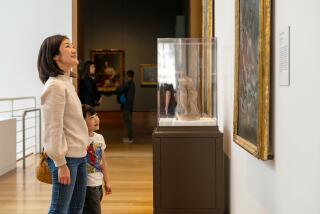Could Getty, LACMA and Hammer museums be free? Directors weigh in
At the Zocalo panel on Friday with L.A. museum directors Timothy Potts, Ann Philbin and Michael Govan, MOCA’s finances were one (brief) topic of conversation.
Personal finances were another: at the end of the panel, an audience member asked a question about making the museums more affordable or free.
Each director had a different take. (Their answers appear about 55 minutes into the video now online at zocalopublicsquare.org, which also ran a recap of the full panel here.)
“We’d love to make our museum free,” Philbin said. But she did note that a consultant brought in at one point made the argument that making museums free can make the experience seem less valuable for visitors. (Thursdays at the Hammer are free; the museum is also free to students, veterans and some other groups.)
Govan responded, “I can be honest, I’d rather be free. [But] it would severely limit the kinds and numbers of programs we could offer because our budgets would be smaller. We’ve tried in different ways and looked at free hours.”
Then he made a pitch for admission as a form of public philanthropy: “I think a certain amount of the public thinks that museums are -- and the Getty is -- on high, and it was one donor who largely established it, but other kinds of museums aren’t like that. They are actually funded by the public, directly.... We have some county money but that’s a generous one-third of our budget. So when people are paying, and it’s less than a movie ticket, they are actually contributing to a museum that serves a lot of people.”
(LACMA is free certain afternoons to county residents and on holiday Mondays; also, anyone under 18 enrolled in the program NexGen can get in free and bring an adult along gratis.)
Potts, who was finishing his first week on the job as the director of the Getty Museum, which has free admission but charges for parking, had the longest response of the three. He described firsthand the benefits of free admission he saw from his time at the helm of the National Gallery of Victoria in Melbourne, Australia and the Fitzwilliam Museum in Cambridge.
“I’m a great believer in free entry, and there are situations in which going free actually makes you more money,” he said, noting that Fitzwilliam was able to attract more corporate sponsorship and government funding because of strong attendance stemming from its free admission policy. “We did much better financially by being free than the relatively small amounts we would have made after you build in all your costs by charging for entry. So it can work,” he said, adding that it depends on many variables at play.
“There’s no question that as museum directors we would all love to be able to open our doors freely and have as many visitors as possible. I’ve been lucky that three of the four museums I’ve been at have done that. Of the one that did charge, which was Melbourne, we pushed very hard with the ministry to be able to take away the charge to the permanent collection -- we still charged for exhibitions. There were a lot of naysayers who said: Well, people won’t value the experience, they won’t come, maybe the attendance will stay the same. We took away a $6 charge, and the attendance more than doubled in the very first year.
“In my mind there’s no question that even a relatively small entry charge is a major hurdle for many people, in fact the ones you most want to come, for whom that $6 is really quite a significant amount. They’re the ones you lose. They’re the first you lose by charging. The people who can afford to collect, have an art history degree, go to museums around the world -- they can still afford it, they can still come. It’s the people who haven’t had all those benefits, but you really want to open their eyes to what an art museum represents, and they’re the ones you lose by charging even a relatively small amount,” he said.
This response prompted one final comment from the audience: “It’s great that the Getty has so much money and can afford to give people free admission. However, admission isn’t free. It’s $15 to park your car, so maybe something could be done about that.”
Potts responded: “Absolutely you’re right, there’s a cost there. It’s a function of the design. It’s on the top of a hill, with a certain amount of parking, limited, how do you control that? It’s not ideal, I absolutely agree. If there were a way to have a magic wand and change the physical form of access and not have to have that parking arrangement, that would be better. Is it feasible? I just don’t know.”
ALSO:
Zocalo panel brings together directors of LACMA, Getty and Hammer
Getty announces hire of Timothy Potts
Hammer Museum names winner of $100,000 Mohn Award
More to Read
The biggest entertainment stories
Get our big stories about Hollywood, film, television, music, arts, culture and more right in your inbox as soon as they publish.
You may occasionally receive promotional content from the Los Angeles Times.






